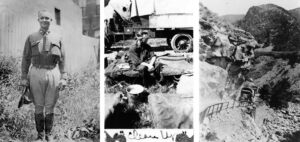If your musical tastes are confined to Top 40 country radio, chances are you’ve never heard of Junior Brown. Despite a career dating back to the 1960s, Brown hasn’t logged an extensive list of hit songs.
In fact, his discography includes only five singles, all released in the mid-1990s.
Still, this artist, billed as an “American Original” (perhaps mixed with a dose of Ernest Tubb), has left his mark on alternative country genres. And, along the way, he even applied his unique style to an original trucking song.
Born June 12, 1952, in Arizona, Brown’s family relocated to Kirksville, Indiana, before he learned to walk. And, as Brown tells the story, his dad taught him to play the piano before he could talk.
During his childhood, Brown says, he found country music unavoidable. He notes that, in Indiana, country music was “growing up out of the ground like the crops — it was everywhere; coming out of cars, houses, gas stations and stores like the soundtrack of a story, but country music programs on TV hadn’t really come along much yet; not until the late fifties.”
After learning to play a guitar he found in his grandparents’ attic, Brown spent his teenage years playing before audiences ranging from private parties and school functions to 5,000 scouts at the annual Boy Scout Jamboree.
During the ’60s, Brown perfected his instrumental skills performing with bands like The Last Mile Ramblers, Dusty Drapes and Asleep at the Wheel. He later broke out on his own and became one of the most prolific performers at clubs throughout the Southwest.
“I played more nights in honky-tonks during the ’70s and ’80s than most musicians will see in a lifetime,” he said.
All the while, he worked to hone his skill on another instrument — the steel guitar. In the end, his repertoire featured so much guitar and steel guitar that switching from one instrument to the other on stage became cumbersome.
The search began for a solution to the problem of playing two instruments simultaneously — and the result was enough to earn Brown his “American Original” tagline.
In 1985, Brown teamed up with Michael Stevens to invent an instrument country music had never seen.
The guit-steel, as it’s now known, is a combination electric and steel guitar. The instrument, which Brown describes as a “double-necked biscuit board,” is larger and heavier that a double-necked guitar.
On stage, the guit-steel rests on a specially designed stand that takes the weight off what would be the player’s shoulders, allowing the guitarist to easily switch between the two instruments mid-song and play them both with precision.
In many ways, the guit-steel turns a Junior Brown performance into something akin to a one-man band, with Brown performing self-penned songs ranging from serious ballads to high-energy, instrumentally focused tunes.
Accompanied by Brown’s increasing skills as a songwriter, the guit-steel led to the development of a “Junior Brown” style that few artists have attempted to replicate.
In the early ’90s, Brown relocated to Austin, Texas, the unofficial home of alternative country music. His growing local popularity, along with his unique style, led to his first recording contract, a seven-record deal with Curb Records.
He recorded 12 albums, but his commercial success was fleeting. As a result, you’ll often hear his music in the most unexpected places.
According to the Junior Brown website, the artist received several Grammy nods, a CMA (Country Music Association) award for “My Wife Thinks You’re Dead,” and has made numerous appearances in movies and TV shows, such as “The X-Files,” “Me, Myself and Irene,” “Blue Collar Comedy” (tours 1 and 2) and, more recently, “Better Call Saul.” And there were the ad campaigns — The Gap, Lee Jeans and Lipton Tea.
As his notoriety grew, Brown collaborated on projects with some of the performers he’d grown up listening to on the radio.
Over the years, he has performed with Ralph Stanley, Hank Thompson, the Beach Boys, George Jones, Doc Watson, Ray Price and others. His website adds, “He even played guitar for Bob Wills’ Texas Playboys in a radio commercial.”
In 1996, Brown released his fifth album, “Semi-Crazy.”
Critics said the album’s songs brought back memories of the type of music country radio “used to play” … “the essence of Western Swing,” packed full of Brown’s “casually irreverent humor.” The album remains his most successful, reaching No. 34 on the country charts. And while the title song was never released as a single, Texas Monthly magazine touted “Semi-Crazy” as the “first decent trucking song in more than a decade.”
As the truck driver narrating “Semi-Crazy,” Brown describes himself as “a slap happy, gear jamming coffee drinking truck driving fool,” but the lyrics’ mild irreverence toward truckers should be taken as nothing less than admiration.
“The more I try to make a buck in this beat up truck, the more semi-crazy I get,” he sings, admitting he’s “half nuts to keep running up and down the road in these semi-trucks.”
And make no mistake, this driver has thought about doing something else for a living — but “I’m never gonna give it up ‘til I’m pushing up daisies.”
Why? Because he’s crazy for semi trucks.
Two stanzas of “Semi-Crazy” are excellent displays of Brown’s dry humor, as the unique songwriter attempts to pay homage to those who keep the nation moving:
“‘I’m just a truck driving fool who never finished school,
I got my learning at the old truck stop.
They said I won’t amount to much when a gear shift
And a clutch was the only education I got.”
And
“I’m just an old blue collar, semi-crazy road scholar
They tell me that I’m half insane.
And I’ve been driving so long, I got diesel in my blood
And ninety weight oil on my brain.”
And for those who question the real intent of Brown’s lyrics as being something more sinister than humorous, another stanza casually (though still humorously) reflects the performer’s admiration for the truck driving profession:
“Everybody says we’re dingy ’cause we’re too semi-crazy to stop.
That’s the handle that we’re stuck with, no matter if we like it or not.
Through the desert and the mountains
The sunshine, the rain and the snow,
We’ll be double clutching daddies ’til we’re over the hill
And we’re never gonna take it slow.”
To put the dot in the exclamation point, the final words Brown utters as “Semi-Crazy” fades offer a nod to one of country music’s best-known performers of truck driving songs: “What do you think of that, Dudley?”
And with the song ended, Brown heads off to another tour stop where he pays his dues to the professional entertainers’ version of “Six Days on the Road.”
Until next time, don’t forget to search the far corners of country music for alternatives to Top 40 radio. After all, listening to those same songs for days on end is enough to drive anyone semi-crazy.
Since retiring from a career as an outdoor recreation professional from the State of Arkansas, Kris Rutherford has worked as a freelance writer and, with his wife, owns and publishes a small Northeast Texas newspaper, The Roxton Progress. Kris has worked as a ghostwriter and editor and has authored seven books of his own. He became interested in the trucking industry as a child in the 1970s when his family traveled the interstates twice a year between their home in Maine and their native Texas. He has been a classic country music enthusiast since the age of nine when he developed a special interest in trucking songs.














